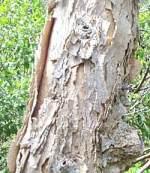Vachellia sieberiana var. woodii
Vachellia sieberiana (DC.) Kyal. & Boatwr. var. woodii (Burtt Davy) Kyal. & Boatwr.
Family: Fabaceae
Common names: paperbark thorn (Eng.); papierbasdoring (Afr.); Mphoka (North Sotho); umNganduzi (Siswati); Mokha, Morumosetlha (Tswana); Musaunga (Venda); umKhamba (Zulu); Nkowankowa (Tsonga)
SA Tree No: 187
Introduction
Pure stands of these beautifully shaped trees with their perfectly flattened crowns are quite stunning. Where else but in Africa would you encounter such a sight?

Description
Description
A magnificent, widely spreading, flat crown (12 m high, 16 m wide) of deep green, feathery foliage (deciduous) and attractive creamy-tan to yellow-brown corky bark, make this an easy tree to identify. The flaky, papery bark peels off in flattish strips, revealing a yellow underbark.

Balls of creamy to pale yellow scented flowers are borne in spring to summer (September to November) and entice insects. Paired thorns are long, strong, straight and white. Light brown, woody pods are formed from autumn (March) onwards, are cylindrical and thickened (often with velvety hairs).

Distribution and habitat
Distribution description
This tree is found in woodland, wooded grassland and along riverbanks (where it can reach 15 m) in South Africa, Swaziland, Zimbabwe, northern and eastern Botswana, northern Namibia and tropical Africa north to Ethiopia.
Derivation of name and historical aspects
History
This tree was previously known as Acacia sieberiana var. woodii. Vachellia refers to George Harvey Vachell (1789 – 1839), chaplain to the British East India Company in Macoa, who collected plants in China ; sieberiana is named for Franz Sieber (1789-1844), a Bohemian botanist, traveller and plant collector.
Ecology
Ecology
This tree is a favourite nesting site for many birds - in valley bushveld areas, Pied and Crested Barbets make their nesting holes in this tree. Wood-hoopoes often scratch around under the loose bark for insects. Grey Hornbills crack the pods open and eat the seeds.
The flowers lure beetles, bees, butterflies and thrips, in turn attracting insectivorous birds (e.g. Bar-throated Apalis, White-bellied, Black and Collared Sunbirds). The pods have a musty scent (like old socks!) and are eaten by cattle and game (said to taint a cow's milk). They contain hydrocyanic acid, so the quantities fed to livestock should be limited (also quantities of wilted leaves).
Uses
Use
In Central Africa, a bark/root decoction is used for inflammation of the urinary passages. Leaf, bark and resin are used as an astringent for colds/chest problems, diarrhoea, haemorrhage and eye inflammation. In Tanzania, bark is used to treat gonorrhoea. The edible gum is a good adhesive. Twine from the inner bark is used for threading beads.
Growing Vachellia sieberiana var. woodii
Grow
This tree is easily propagated from seed that has been immersed in boiling water and soaked overnight. Protect young plants from frost. They are suited to medium to large gardens. Allow these magnificent trees the space to show off their wonderful shapes - don't crowd and clutter them. However, on a large property, five to six trees planted fairly close together make an impressive group.
This tree is half-hardy and very fast-growing with fertile soil and sufficient water, and tolerates temperatures ranging from about -2°C to 40°C. Plant in the sun.
References
- Coates Palgrave, K. 1988. Trees of southern Africa, Struik, Cape Town.
- Germishuizen, G. & Fabian, A. 1982. Transvaal wild flowers. Macmillan, Johannesburg.
- Joffe, P. 2001. Creative gardening with indigenous plants - a South African guide. Briza Publications, Pretoria.
- Palmer, E. & Pitman, N. 1972. Trees of southern Africa. Balkema, Cape Town.
- Pooley, E. 1993. The complete guide to trees of Natal, Zululand and Transkei. Natal Flora Publications Trust, Durban.
- Van Wyk, B. & Van Wyk, P. 1997. Field guide to the trees of southern Africa. Struik, Cape Town.
- Van Wyk, B., Van Wyk, P. & Van Wyk B-E. 2000. Photographic guide to trees of southern Africa. Briza Publications, Pretoria.
- Von Koenen, E. 1996. Medicinal, poisonous and edible plants in Namibia. Klaus Hess, Windhoek.
- Watt, J.M. & Breyer-Brandwijk, M.G. 1962. The medicinal and poisonous plants of southern and eastern Africa. Livingstone, London.
Credits
Pitta Joffe
Pretoria National Botanical Garden
October 2003
Plant Attributes:
Plant Type: Tree
SA Distribution: Gauteng, KwaZulu-Natal, Limpopo, Mpumalanga
Soil type: Sandy, Loam
Flowering season: Spring, Early Summer, Late Summer
PH: Neutral
Flower colour: Cream
Aspect: Full Sun
Gardening skill: Easy
Special Features:
Horticultural zones











Rate this article
Article well written and informative
Rate this plant
Is this an interesting plant?
Login to add your Comment
Back to topNot registered yet? Click here to register.